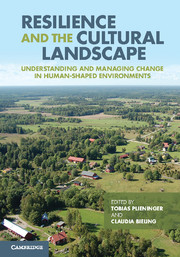 Resilience and the Cultural Landscape
Resilience and the Cultural Landscape Book contents
- Frontmatter
- Contents
- List of contributors
- Preface
- Part I Conceptualising landscapes as social–ecological systems
- Part II Analysing landscape resilience
- Part III Managing landscapes for resilience
- 12 Collective efforts to manage cultural landscapes for resilience
- 13 Response strategy assessment: a tool for evaluating resilience for the management of social–ecological systems
- 14 Ecosystem services and social–ecological resilience in transhumance cultural landscapes: learning from the past, looking for a future
- 15 The role of homegardens in strengthening social–ecological resilience: case studies from Cuba and Austria
- 16 Promises and pitfalls of adaptive management in resilience thinking: the lens of political ecology
- Part IV Perspectives for resilient landscapes
- Index
- References
14 - Ecosystem services and social–ecological resilience in transhumance cultural landscapes: learning from the past, looking for a future
Published online by Cambridge University Press: 05 November 2012
- Frontmatter
- Contents
- List of contributors
- Preface
- Part I Conceptualising landscapes as social–ecological systems
- Part II Analysing landscape resilience
- Part III Managing landscapes for resilience
- 12 Collective efforts to manage cultural landscapes for resilience
- 13 Response strategy assessment: a tool for evaluating resilience for the management of social–ecological systems
- 14 Ecosystem services and social–ecological resilience in transhumance cultural landscapes: learning from the past, looking for a future
- 15 The role of homegardens in strengthening social–ecological resilience: case studies from Cuba and Austria
- 16 Promises and pitfalls of adaptive management in resilience thinking: the lens of political ecology
- Part IV Perspectives for resilient landscapes
- Index
- References
Summary
Introduction
Transhumance is a seasonal migration of livestock between summer pastures (highlands, usually northerly latitudes) and winter pastures (lowlands, southerly latitudes). Matching a herd’s need for forage with seasonal peaks in pasture availability assures the best year-round supply of feed for the animals (Manzano-Baena & Casas, 2010; Ruiz & Ruiz, 1986). Transhumance is one of the many customary practices developed by ancient Mediterranean societies to cope with an unpredictable and highly fluctuating climate. It creates a cultural landscape that includes a complex mosaic of habitats, each varying in extent and productivity during the year. In addition, transhumance creates social interactions and connections that would not occur without it. The social and ecological characteristics of transhumance landscapes, in turn, shape the ecosystem services they provide.
In Spain, transhumance reached its peak during the Middle Ages with the official formation of the Council of the Mesta, an association of transhumant livestock herders whose main objective was to defend their rights in the conflicts with sedentary farmers and local livestock raisers as they migrated among seasonal pastures. During its peak, the number of sheep involved in these movements came to be almost four million, with herds covering distances of up to 700 km along a network of drove roads protected from damage and intrusion, twice a year. With the breakdown of the Merino breed monopoly and its valuable wool during the nineteenth century, a continuous decline of transhumance in Spain began. During the twentieth century, the use of rail transport has gradually taken the place of herding along drove roads.
- Type
- Chapter
- Information
- Resilience and the Cultural LandscapeUnderstanding and Managing Change in Human-Shaped Environments, pp. 242 - 260Publisher: Cambridge University PressPrint publication year: 2012
References
- 10
- Cited by


